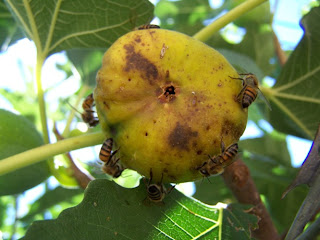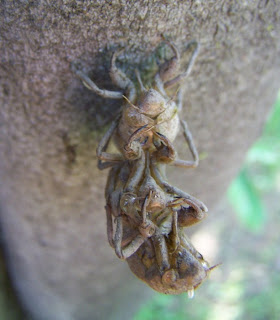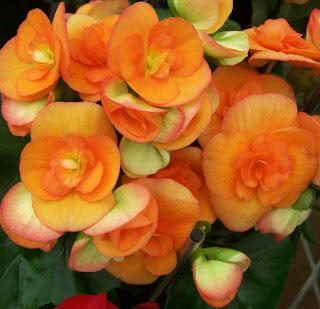Thursday, October 30, 2008
Tuesday, October 28, 2008
Prong-tailed Weevil (Bronchus furvus) Family Curculionidae
We have Weevils (family Curculionidea) of all sizes and colors here. This one is of the larger species being almost 2 inches in body length.


Monday, October 27, 2008
Sunday, October 26, 2008
Amarilla - life cycle
The Amarilla is grown from a bulb and are summer flowering. They grow very well in pots for people who do not have gardens. When a flower dies off, cut the stem off just above the ground. In winter, take the bulb out and preserve is in a cool, dry place, packed in wood shavings. About 2/3 months before spring, take it out and begin to water it again. 
Saturday, October 25, 2008
Pygmy Emperor Moth (Rohaniella pygmaea) Saturniidae
Is this not the most beautiful moth you have ever seen???? It is large, 4-5 inches in width. They are nocturnal and only live for 3-5 days. The males have this comb-like antennae.


Thursday, October 23, 2008
Wednesday, October 22, 2008
Fluffball Chafer (xeloma tomentosa) Scarabaeidae
Also called Gold-haired Fruit Chafer This is a small beetle being only about a half inch in body length. The adults feed on flowers.


Tuesday, October 21, 2008
Cicadas
Monday, October 20, 2008
Special occasions
Sunday, October 19, 2008
CMR Bean Beetle (Mylabris oculata) Meloidae
These belong to the same family as blister beetles and are the bane of anyone who has a lovely garden. They eat every flower your have plus cotton, beans and citrus crops.
 They are just over an inch in body length. The larvae however, regulate the numbers of grasshopper by parasitizing their egg pods.
They are just over an inch in body length. The larvae however, regulate the numbers of grasshopper by parasitizing their egg pods.
 They are just over an inch in body length. The larvae however, regulate the numbers of grasshopper by parasitizing their egg pods.
They are just over an inch in body length. The larvae however, regulate the numbers of grasshopper by parasitizing their egg pods.Saturday, October 18, 2008
I'M CELEBRATING!!
Thursday, October 16, 2008
You can't see me....
DID YOU KNOW THAT FIGS ARE A FLOWER AND NOT A FRUIT??
This first one reminds me of John Cena on WWW ..... "You can't see me". LOL!!
When the figs are ripe you do not get the chance to pick any as they are covered in bees.
 Common Fig is widely grown for its edible fruit throughout its natural range in Iran and also in the rest of the Mediterranean region and other areas of the world with a similar climate.
Common Fig is widely grown for its edible fruit throughout its natural range in Iran and also in the rest of the Mediterranean region and other areas of the world with a similar climate. 
This first one reminds me of John Cena on WWW ..... "You can't see me". LOL!!
When the figs are ripe you do not get the chance to pick any as they are covered in bees.
 Common Fig is widely grown for its edible fruit throughout its natural range in Iran and also in the rest of the Mediterranean region and other areas of the world with a similar climate.
Common Fig is widely grown for its edible fruit throughout its natural range in Iran and also in the rest of the Mediterranean region and other areas of the world with a similar climate. 
It has been an important food crop for thousands of years, and was also thought to be highly beneficial in the diet. The edible fig is one of the first plants that were cultivated by humans
 Nine subfossil figs of a parthenocarpic type dating to about 9400–9200 BC were found in the early Neolithic village Gilgal I (in the Jordan Valley, 13 km north of Jericho). The find predates the domestication of wheat, barley and legumes, and may thus be the first known instance of agriculture.
Nine subfossil figs of a parthenocarpic type dating to about 9400–9200 BC were found in the early Neolithic village Gilgal I (in the Jordan Valley, 13 km north of Jericho). The find predates the domestication of wheat, barley and legumes, and may thus be the first known instance of agriculture.
 Figs can be eaten fresh or dried, and used in jam-making. Most commercial production is in dried or otherwise processed forms, since the ripe fruit does not transport well, and once picked does not keep well. In Bengal, the fruit is called Dumur. It is cooked as a vegetable and is believed to be good for heart ailments.
Figs can be eaten fresh or dried, and used in jam-making. Most commercial production is in dried or otherwise processed forms, since the ripe fruit does not transport well, and once picked does not keep well. In Bengal, the fruit is called Dumur. It is cooked as a vegetable and is believed to be good for heart ailments.
 Figs are one of the highest plant sources of calcium and fiber. According to USDA data for the Mission variety, dried figs are richest in fiber, copper, manganese, magnesium, potassium, calcium, and vitamin K, relative to human needs. They have smaller amounts of many other nutrients. Figs have a laxative effect and contain many antioxidants.
Figs are one of the highest plant sources of calcium and fiber. According to USDA data for the Mission variety, dried figs are richest in fiber, copper, manganese, magnesium, potassium, calcium, and vitamin K, relative to human needs. They have smaller amounts of many other nutrients. Figs have a laxative effect and contain many antioxidants.
 Nine subfossil figs of a parthenocarpic type dating to about 9400–9200 BC were found in the early Neolithic village Gilgal I (in the Jordan Valley, 13 km north of Jericho). The find predates the domestication of wheat, barley and legumes, and may thus be the first known instance of agriculture.
Nine subfossil figs of a parthenocarpic type dating to about 9400–9200 BC were found in the early Neolithic village Gilgal I (in the Jordan Valley, 13 km north of Jericho). The find predates the domestication of wheat, barley and legumes, and may thus be the first known instance of agriculture. Figs can be eaten fresh or dried, and used in jam-making. Most commercial production is in dried or otherwise processed forms, since the ripe fruit does not transport well, and once picked does not keep well. In Bengal, the fruit is called Dumur. It is cooked as a vegetable and is believed to be good for heart ailments.
Figs can be eaten fresh or dried, and used in jam-making. Most commercial production is in dried or otherwise processed forms, since the ripe fruit does not transport well, and once picked does not keep well. In Bengal, the fruit is called Dumur. It is cooked as a vegetable and is believed to be good for heart ailments. Figs are one of the highest plant sources of calcium and fiber. According to USDA data for the Mission variety, dried figs are richest in fiber, copper, manganese, magnesium, potassium, calcium, and vitamin K, relative to human needs. They have smaller amounts of many other nutrients. Figs have a laxative effect and contain many antioxidants.
Figs are one of the highest plant sources of calcium and fiber. According to USDA data for the Mission variety, dried figs are richest in fiber, copper, manganese, magnesium, potassium, calcium, and vitamin K, relative to human needs. They have smaller amounts of many other nutrients. Figs have a laxative effect and contain many antioxidants.Tuesday, October 14, 2008
Subscribe to:
Posts (Atom)






























